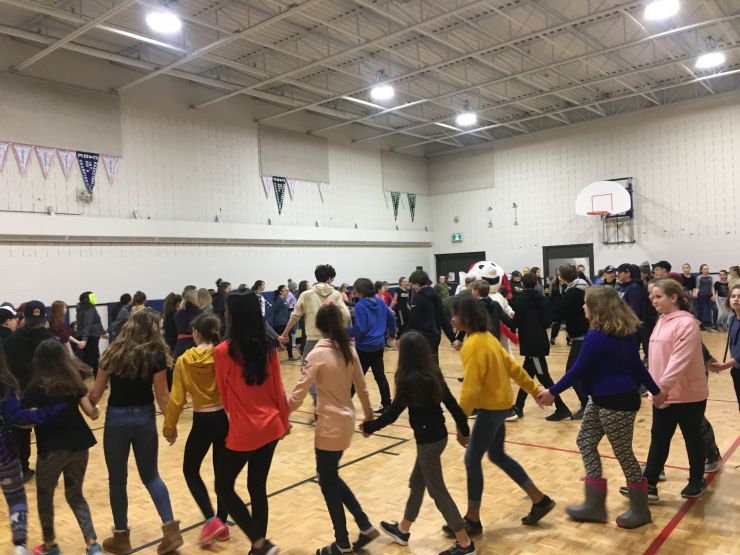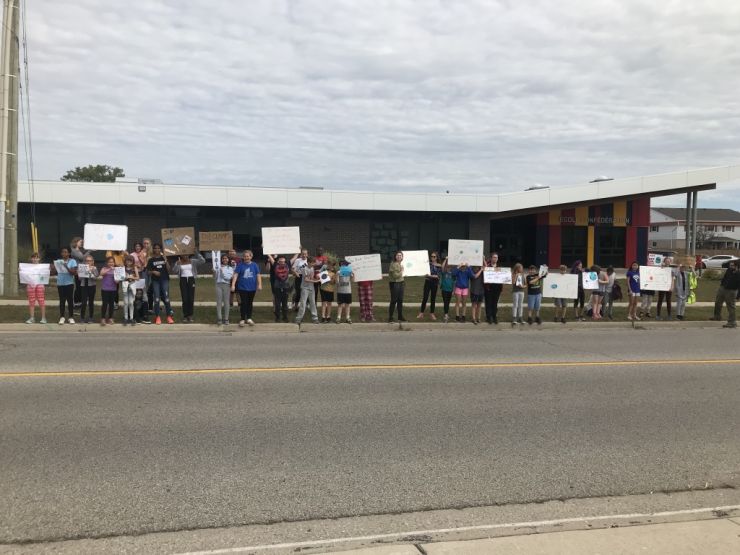Le Carnaval de Quebec at École Confédération

Le Carnaval de Québec existe depuis 64 ans, depuis 1955, mais les festivals d’hiver de Québec avaient commencé bien avant. Des carnavals hivernaux ont eu lieu au Québec pour soulager l’ennui de l’hiver et ils remontent à la Nouvelle-France.
À Québec, le premier carnaval d'hiver a eu lieu en 1894, mais il a été interrompu par les deux guerres mondiales et la Grande Dépression.
En 1954, un groupe d'hommes d'affaires de la ville de Québec décident de ramener le carnaval à une plus grande échelle afin de favoriser le développement économique de la région. Le premier Carnaval « moderne » de Québec a eu lieu en 1955 et c'est à ce moment-là que Bonhomme a été choisi comme mascotte de l'événement. Bonhomme, qui signifie bonhomme de neige, est connu comme l'ambassadeur officiel du Carnaval de Québec. C’est un gros bonhomme de neige coiffé d’un bonnet rouge, de boutons noirs et d’une ceinture fléchée traditionnelle canadienne-française.
Le Carnaval de Québec est le plus ancien et le plus célèbre des festivals d’hiver organisés chaque année au Canada. Le Carnaval est rapidement devenu un événement incontournable pour la population locale et un moteur important du tourisme dans la ville. Au fil des ans, le Carnaval a ajouté de nombreux sports et activités de sports d'hiver inspirés du mode de vie traditionnel québécois.
Fidèle à la tradition canadienne, l'École Confédération célèbre chaque année le Carnaval depuis 10 ans. Depuis 2014, le Carnaval est organisé au Centre communautaire Branlyn où Bonhomme fait une apparition et les élèves et les parents se profitent d'une soirée de chant et de danse. Au cours de la semaine, les étudiants apprennent l’histoire du Carnaval de Québec et travaillent sur leur masque pour « le bal masqué ». Nos étudiants ont tenu une danse au gymnase où un groupe de musiciens a joué de la musique traditionnelle québécoise. Le 20 février à 18 heures, malgré la neige et la glace, nous avons passé une belle soirée de musique, chants et collations, grâce à la collaboration et à la participation des enseignants, du conseil de parents, de l’administration, de musiciens et principalement d’élèves ayant participé à ces activités. Nous avons célébré une tranche de culture franco-canadienne qui nous rend uniques à l'École Confédération. Le 22 mars également, nous nous sommes habillés comme notre super-héros préféré pour célébrer le fait que nous sommes tous uniques et différents et que nous possédons tous des pouvoirs extraordinaires. Nous avons passé une excellente journée à jouer avec nos amis, à apprendre à travailler ensemble, à partager et à collaborer.English translation:
Carnaval has been running for 64 years, since 1955, but winter festivals in Quebec City got their start long before that. Winter carnivals in Québec were held to relieve the tedium of winter, and they date back to New France.
In Quebec City, the first large-scale winter carnival occurred in 1894, but it was interrupted by both world wars and the Great Depression.
In 1954, a group of Quebec City businessmen decided to bring the carnival back on a grander scale in order to promote the economic development of the region. The first “modern” Carnaval de Québec took place in 1955, and at this point, Bonhomme was chosen as the event’s representative mascot. Bonhomme short for bonhomme de neige, or “snowman,” is known as the official ambassador of the Carnaval de Québec. He’s a large snowman sporting a red cap, black buttons, and a traditional French Canadian ceinture fléchée, or “arrowed sash.”
The Québec Winter Carnival is the oldest and most famous of the winter festivals that take place each year across Canada. The popular tradition of holding a mid-winter celebration in Quebec City can even be traced back to the colonial history of New France.
The Carnaval soon became a must-see event for the local population and a significant driver of tourism in the city. Over the years, the Carnaval has added many winter sports and activities inspired by the traditional Québécois way of life.
Keeping up with this Canadian tradition École Confédération has celebrated Carnaval every year for the past 10 years and since 2014 Carnaval has been hosted at Branlyn Community Centre. Bonhomme makes an appearance and students and parents enjoy an evening of song and dance. During the week students learned about Carnaval de Québec, and worked on their mask for the “Bal masqué”. Our students held a dance in the gym were group of musicians play some traditional Quebecois music. On February 20th, despite snow and ice, we spent a beautiful evening of music, song and snacks, thanks to the collaboration and participation of teachers, parent council, administration, musicians and mainly students who took part in these activities. We celebrated a slice of French-Canadian culture that makes us unique here at École Confederation.

We are an Eco-School
Did you know our school is an eco-school? Well we are, and that means that our school is making efforts every day to stay green. Some of the things our energy efficiency group is doing include implementing eco-friendly browsers, starting lights out lunches every Monday and Friday, creating signs for lights and monitors, and adding important information to our school website about being eco-friendly. We're also having a fun sweater day where we’re lowering the temperature of the school by two degrees and we will all wear sweaters. We’re also adding Ecosia to all our browsers. Ecosia is a company that plants a tree for every forty-five searches on the internet. Students are also making fifteen signs and posting them around the school, to remind people to turn off lights and monitors. Sweater day will be held on the 29th of November, and the 16th and 17th of December. Remember to check the school website for more cool information about how we are going eco-friendly, and the steps to become a platinum school, and to watch a video about implementing eco-friendly habits. Always remember to stay green!
From,
The Energy Efficiency Team of École Confédération
More News

